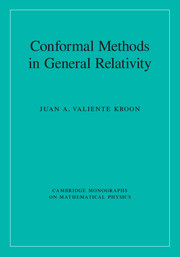Book contents
- Frontmatter
- Dedication
- Contents
- Preface
- Acknowledgements
- List of Symbols
- 1 Introduction
- Part I Geometric tools
- Part II General relativity and conformal geometry
- Part III Methods of the theory of partial differential equations
- 11 The conformal constraint equations
- 12 Methods of the theory of hyperbolic differential equations
- 13 Hyperbolic reductions
- 14 Causality and the Cauchy problem in general relativity
- Part IV Applications
- References
- Index
13 - Hyperbolic reductions
from Part III - Methods of the theory of partial differential equations
- Frontmatter
- Dedication
- Contents
- Preface
- Acknowledgements
- List of Symbols
- 1 Introduction
- Part I Geometric tools
- Part II General relativity and conformal geometry
- Part III Methods of the theory of partial differential equations
- 11 The conformal constraint equations
- 12 Methods of the theory of hyperbolic differential equations
- 13 Hyperbolic reductions
- 14 Causality and the Cauchy problem in general relativity
- Part IV Applications
- References
- Index
Summary
This chapter discusses several methods for the construction of symmetric hyperbolic evolution systems out of the conformal Einstein field equations. Once suitable evolution systems have been obtained, the methods of Chapter 12 allow, in turn, one to make statements about the existence of solutions to the equations. Direct inspection of the conformal field equations reveals that these are overdetermined – there are more equations than unknowns, even if the symmetries of the various tensorial and spinorial fields are taken into account. Thus, the process of hyperbolic reduction for the conformal field equations necessarily requires discarding some of the equations. The discarded equations are then treated as constraints. It is a remarkable structural property of the conformal field equations that these constraints satisfy a system of evolution equations – a so-called subsidiary evolution system – from where it can be concluded that the constraint equations will be satisfied if they hold at some initial hypersurface and the evolution equations are imposed. This construction is called the propagation of the constraints. The solution of the evolution system together with the propagation of the constraints yields the required solution of the conformal Einstein field equations.
In this chapter, two different procedures for the hyperbolic reduction of the conformal Einstein field equations are considered. The first method, based on the notion of gauge source functions, exploits the fact that certain derivatives of the conformal fields are not directly determined by the equations and, thus, can be freely specified. In the spinorial formulation of the equations, once the required gauge source functions have been specified, the irreducible decomposition of the various zero quantities leads to the required evolution equations. The equations obtained by this procedure include the conformal factor as an unknown.
The second hyperbolic reduction procedure presented in this chapter exploits the properties of congruences of conformal geodesics to construct conformal Gaussian gauge systems. As discussed in Chapter 5, the connection coefficients and components of the Schouten tensor with respect to a frame which is Weyl propagated along the congruence satisfy certain relations which lead to a particularly simple system of equations in which the evolution of all the geometric unknowns, save for the components of the rescaled Weyl spinor, are either fixed by the gauge or given by transport equations along the congruence.
- Type
- Chapter
- Information
- Conformal Methods in General Relativity , pp. 331 - 389Publisher: Cambridge University PressPrint publication year: 2016

